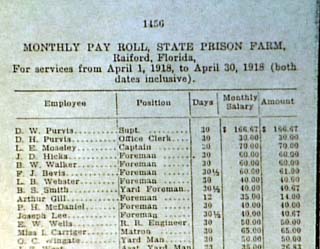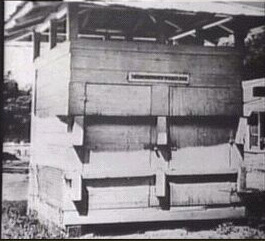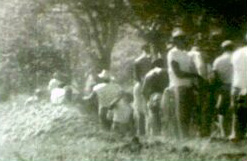1919
INMATE POPULATION: 485
By now, forty guards are employed at Raiford State Prison Farm. Each earns $35 per month, plus board.
The Raiford State Prison Farm property consists of 4,000 acres under cultivation, extensive pastures, a garment factory and a shoe factory that makes 10 pairs of shoes per day.

This 1918 payroll statement shows the superintendant received $166.67, the captain $70; office clerk $30 and foremen between $40 and $60 for the month of April. It is interesting to note that, at a time when most women did not work, a Miss L. Carriger was making $65 a month as a prison matron, more than some of the men in other jobs listed.
BRADFORD COUNTY TELEGRAPH
24 JANUARY 1919
The State Farm is now much improved under the management of Capt. J. S. BLITCH. His motto is "Co-operation."
BRADFORD COUNTY TELEGRAPH
14 FEBRUARY 1919
STATE FARM - The humanizing influence of Capt. BLITCH'S work is being felt in every department and better results are obtained than usual. What is being done here by the methods of Capt. BLITCH will put this farm one of the best managed in the United States, and these methods will be copied by other states and the cause of humanity largely advanced. Capt. BLITCH'S son, who has been so critically ill for some days, is now up. The State Farm Amusement Co., were unable to put on "Little Miss Nobody" last Saturday night, so the minstrel put on a good show closing with the "Old Plantation", and was thoroughly enjoyed by the entire audience. "Little Miss Nobody" will be put on next Saturday night. These shows have been put on for the amusement of the inmates and are doing a lot of good. Visitors are gladly welcomed, not only to the show but also to see what is done on the farm, and the condition of the prisoners. Sunday afternoon a good game of baseball was played. Hereafter, a game will be played every Sunday afternoon at four o'clock. Senator CRANE, a prisoner, is now in the office and will have charge of the Statistics. He is succeeded in the oil room by J. L. BRANCE, also a prisoner. Strange as it may seem over half of the white prisoners are here under murder and life sentences are largely trustys. All live in hope of being pardoned so that they may return to their families who need their care and assistance. The oats on the farm are looking much better. The cold weather and rains had only retarded their growth.

Playing baseball at Raiford Prison. (Photo courtesy of FPC.)
Florida's chain gangs are introduced in 1919 partly because an increasing number of roads are needed to keep pace with the growing number of tourists to Florida. There is no classification of inmates on the chain gangs--those with petty crimes work side-by-side with inmates serving life sentences and even the mentally ill. Inmates are separated by race and if they have tuberculosis. Inmates attached to leg irons build public roads while correctional officers with shotguns spur them on and discourage potential escapees.

Inmates building Florida roads. (Photo courtesy of FPC.)

Chain gang and horse drawn plow.
Even after the convict leasing system is abolished in 1923, prison chain gangs continue because Florida needs the roads to accommodate tourism. According to an article by Marlene Womack in the April 5, 1998 Panama City News Herald, the life of a chain gang member is as difficult as that of leased inmates.
CHAIN GANGS
"Like leased convicts, inmates working on chain gangs toiled from daylight until dark. Prisoners who were considered escape risks wore heavy shackles that were riveted in place on their legs and never removed. These shackles cut deep into the ankles unless straps of leather, called garters, were worn to prevent injury.
The "walking boss" oversaw a group of 20 to 30 inmates, known as a "bull gang." Those caught "eyeballing," or looking at the outside world, felt the sting of his whipping cane.
Free men or guards carried shotguns and stood around the chained convicts as they worked. Prison camps were placed in isolated sections of the woods. Food often consisted of nothing more than beans and molasses.
Those committing more serious crimes such as talking in line or asking a guard for the time were locked in the dreaded "sweat boxes" for a day or longer. These wooden boxes measured about 6 feet long and 6 feet high by 3 feet across. The boxes were similar to outhouses but contained no windows.
Prisoners working the roads became a common sight in Florida and several other states. In later years, convict camps also existed in this area at places like Lake Merial and in Panama City south of 15th Street on the west side of Balboa Avenue.

The infamous sweat box is a small enclosure, so small a single man barely had enough room to sit. A man could stand up and would often stay in the box for two days with two or three other men.

Florida chain gang crew.
- 1821-1845
- 1868-1876
- 1877-1895
- 1900-1919
- 1921
- 1922-1924
- 1927
- 1928-1931
- 1932 | CHAPMAN
- 1933-1935
- 1936-1939
- 1940-1945
- 1946-1949
- 1950-1955
- 1956-1961
- 1962 | WAINWRIGHT
- 1963-1965
- 1966-1969
- 1970-1975
- 1976-1979
- 1980-1986
- 1987 | DUGGER
- 1988-1990
- 1991 | SINGLETARY
- 1992-1995
- 1996-1998
- 1999 | MOORE
- 2000-2002
- 2003 | CROSBY
- 2004-2005
- 2006 | MCDONOUGH
- 2007
- 2008 | MCNEIL
- 2009-2010
- 2011 | BUSS
- 2011 | TUCKER
- 2012 | CREWS
- 2013-2014
- 2014 | JONES
- 2015-2018
- 2019 | INCH
- 2020-2021
- 2021 | DIXON
- 2022-Today
- Population Summary Table

